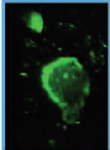|
|
|
Pathophysiological relevance of glycosaminoglycans in Pseudomonas aeruginosa chronic lung
|
|
|
|
|
|
|
|
|
|

|
|
|
Riva C, Lorè NI, Sipione B, Veraldi N, Cariani L, Girelli D, De Fino I, Nonis A, Scalzi E, Spagnuolo L, Bragonzi A, Colombo C, Naggi A, Cigana C
|
|
|
|
IRCCS San Raffaele Scientific Institute
|
Division of Immunology, Transplantation and Infectious Diseases, IRCCS San Raffaele Scientific Institute, Milano, Italy; Istituto di Ricerche Chimiche e Biochimiche “G. Ronzoni”, Milano, Italy
|
|
info@postdocjournal.com
|
|
|
|
|
|
|
|
|
|

|
|
Background. P. aeruginosa chronic colonization of CF airways is associated to physical changes, characterized by mucus hypersecretion, degradation of extracellular matrix, and high levels of sulphated glycosaminoglycans (sGAG).
Hypothesis and objectives. We hypothesized that during P. aeruginosa chronic lung infection there is an increasing concentration and sulphation of different sGAG, contributing to inflammation and tissue damage. Thus the objectives of this project were to establish the role of sGAG during P. aeruginosa chronic infection and to modulate the vicious inflammation-damage cycle using modified polysaccarides (PS) derived from heparin.
|
|
|
|
|
|
|
|

|
|